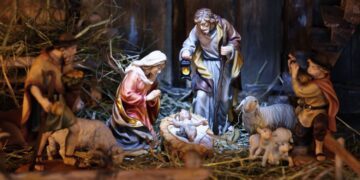Globally, red and green are famously the colors that represent Christmas.
Whenever we see these two colors together we automatically associate it with the holidays.
But why is it just these two colors and where did the association come from?
Although no one knows the origins of red and green at Christmas for certain, there are many theories.
In this article, we will look at the possible reasons why these became the colors of the season.
Why are red and green associated with Christmas?

Christmas is the time of year where we celebrate the birth of Jesus Christ, but over the decades it has become more about exchanging gifts and spending time with our family and friends.
There are simple associations that make us think of these colors, Santa’s suit is red and a Christmas tree is green.
But the use of these two colors stems back further.
In Christianity, it is taught that the red represents the blood of Jesus when he was crucified, and the green represents the eternal life of Jesus like an evergreen tree.
Some people claim it comes from holly bushes, with their red berries and dark green leaves as they thrive at that time of year.
Holly bushes are used to make wreaths that we hang on our front doors during the holiday season so they are a popular image at this time of year.
There are many links and stories that are claimed to be the reason for the color choices at Christmas.
Some people believe that the colors have come from more commercial influences.
Where did the color red originate in association with Christmas?

Although red has been a prominent color used at Christmas, it is said that Coca-Cola was the one who made it a dominant color.
In 1931 Coca-Cola advertisements became more popular in magazines, especially when approaching the holidays.
One of the first advertisements was commissioned to illustrator Haddon Sundblom, with the instructions of creating an advertisement with Santa Claus drinking Coca-Cola.
Sundblom wanted to create an image of the real Santa, rather than of someone dressed as Santa.
This was a turning point in history because the illustration of Santa was so lifelike that it became the image representation of the real Father Christmas.
Santa wore red and from then on, Coca-Cola has continued to advertise with its red branding and hence becoming an associated color of Christmas.
Why did the color green become associated with Christmas?

The association of green at Christmas doesn’t have quite a significant defining moment like the color red.
Many associations point back to the flora and concept of bringing an evergreen tree into the home around Christmas time.
The first documentation of bringing a tree into the home is in Roman culture when they celebrated Saturnalia.
This was to honor the God Saturn and was celebrated from December 17 to 23.
Traditions involved decorating the home with holly and evergreen trees, which would be decorated with small figures.
This is one of the oldest examples of trees being brought inside during the winter to decorate the home.
The color green is widely associated with Christmas because we decorate our homes with trees, holly, and mistletoe.
What other colors were used at Christmas in history?

Victorian Christmas cards show that various combinations of colors were paired when it came to Christmas.
Victorian cards use color combinations like red and green, red and blue, blue and green, blue and white.
Original decorations would have come from natural elements found at that time of year across the flora and fauna, which had an array of colors.
Many are still reflected at Christmas today such as snow, icicles, robins, holly, and mistletoe.
Santa Claus was even depicted wearing different colored suits, from red to green and blue.
It wasn’t until 1931 when Christmas started to become more of a commercial holiday and this is when green and red became the defining colors.
Like other holidays, Christmas has its traditions and associations.
Some are more recent than others but red and green have been the colors of Christmas for hundreds of years.
It would seem that due to the commercialization of the holiday, it has resulted in these two colors becoming the most prominent at Christmas.
Much like orange and black at Halloween, red and green have stuck as being the representational colors of that time of year.


















